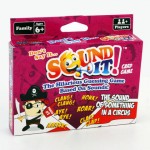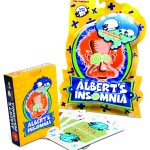The standard 52-card deck of playing cards can be used to play literally hundreds of different games. But despite its versatility, there are some limitations. In recent years dozens of new card games—games that have almost nothing in common with standard decks excerpt that they’re generally rectangular and are printed on thick card stock. Here are three really fun—and completely unique—games to play with the whole family.
 SoundIt! We first discovered SoundIt! in early 2012, and it definitely triggered a definitely had a why-hadn’t-anyone-thought-of-this-before? moment. The basic premise is pretty simple. Each of the 96 playing cards has two parts. One is the description of a sound, say “The sound of something at an amusement park.” The other is an image, which might simple, like a cuckoo clock, or more abstract, like the sky or goo running down a wall. Players have to either guess what the image is based on sounds other players are making, or they have to make the sound in the written clue. It is absolutely uproarious–and something parents and kids of all ages (although six and up with have the most fun) will enjoy playing together. www.wowopolis.com
SoundIt! We first discovered SoundIt! in early 2012, and it definitely triggered a definitely had a why-hadn’t-anyone-thought-of-this-before? moment. The basic premise is pretty simple. Each of the 96 playing cards has two parts. One is the description of a sound, say “The sound of something at an amusement park.” The other is an image, which might simple, like a cuckoo clock, or more abstract, like the sky or goo running down a wall. Players have to either guess what the image is based on sounds other players are making, or they have to make the sound in the written clue. It is absolutely uproarious–and something parents and kids of all ages (although six and up with have the most fun) will enjoy playing together. www.wowopolis.com
 Albert’s Insomnia. This is one of the most fun–and most educational–games we’ve seen in years. And not a battery or an LED in sight. There’s a whole backstory to the game, about sheep herding, but the basic idea is to use cards to add one to the previous player’s total. Start with cards numbered 1, 2, 3, and 4 face up on the table (as in the picture). Using at least two cards, you can add, subtract, multiply, or divide but can use any card only once. So the first player might start with 4-3 = 1. The next says 4-2 = 2; the next says 2+1 = 3. It’s very easy at first, but the higher you go, the harder it gets (4×3 is 12, minus 1 is 11, times 2 is 22, for example). Once you max out what you can do with 1, 2, 3, 4 (somewhere around 36: 4×3 = 12, 2+1 is 3, 3×12 = 36), add a 5 and keep on counting, one number at a time, getting more and more challenging as you go. Albert’s Insomnia is great for teaching math skills because all the calculations have to be done in your head. I played this game with a car full of kids and it kept them (and me) busy and entertained for more than an hour. Ages 6 and up. www.rjb3games.com
Albert’s Insomnia. This is one of the most fun–and most educational–games we’ve seen in years. And not a battery or an LED in sight. There’s a whole backstory to the game, about sheep herding, but the basic idea is to use cards to add one to the previous player’s total. Start with cards numbered 1, 2, 3, and 4 face up on the table (as in the picture). Using at least two cards, you can add, subtract, multiply, or divide but can use any card only once. So the first player might start with 4-3 = 1. The next says 4-2 = 2; the next says 2+1 = 3. It’s very easy at first, but the higher you go, the harder it gets (4×3 is 12, minus 1 is 11, times 2 is 22, for example). Once you max out what you can do with 1, 2, 3, 4 (somewhere around 36: 4×3 = 12, 2+1 is 3, 3×12 = 36), add a 5 and keep on counting, one number at a time, getting more and more challenging as you go. Albert’s Insomnia is great for teaching math skills because all the calculations have to be done in your head. I played this game with a car full of kids and it kept them (and me) busy and entertained for more than an hour. Ages 6 and up. www.rjb3games.com
 Kwizniac Kwizniac is a trivia countdown game. What does that mean? Well, each card in the deck contains an answer and ten clues, which are listed in decreasing order of difficulty. For example, on one card, the first clue (number 10) is “Philip Astley was the first person to put together the elements for it in 1768.” Huh? So we’d move on to the next one (9) “It has been around since the Ancient Romans.” Still huh? The clues get progressively easier until the last one (number 1) is “Clowns are common in this form of entertainment.” Got it? The circus. The object is to get the answer with the fewest number of clues. Ages 10 and up, although Kwizniac Kidz, which has only five clues per card, is good for 6 and up. www.kwizniac.com
Kwizniac Kwizniac is a trivia countdown game. What does that mean? Well, each card in the deck contains an answer and ten clues, which are listed in decreasing order of difficulty. For example, on one card, the first clue (number 10) is “Philip Astley was the first person to put together the elements for it in 1768.” Huh? So we’d move on to the next one (9) “It has been around since the Ancient Romans.” Still huh? The clues get progressively easier until the last one (number 1) is “Clowns are common in this form of entertainment.” Got it? The circus. The object is to get the answer with the fewest number of clues. Ages 10 and up, although Kwizniac Kidz, which has only five clues per card, is good for 6 and up. www.kwizniac.com
